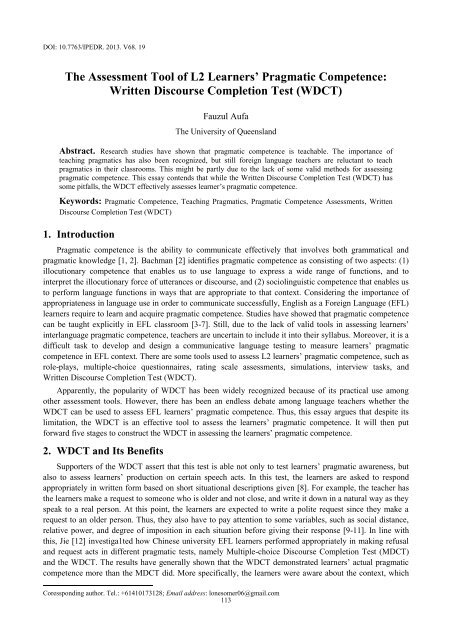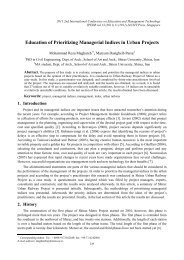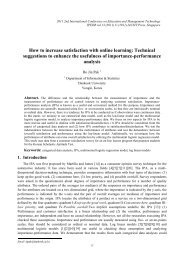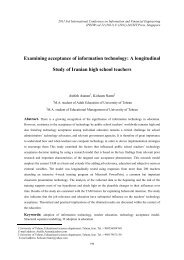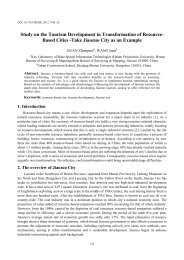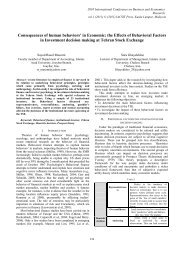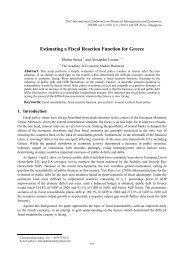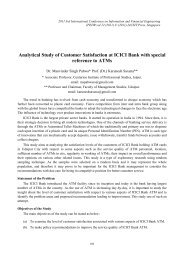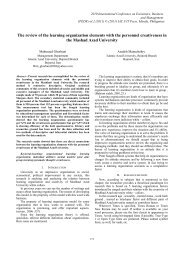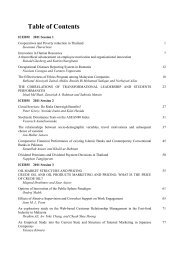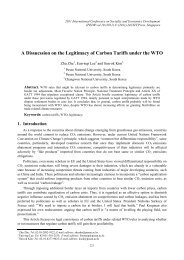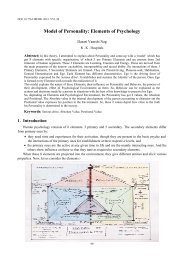Pragmatic Competence: Written Discourse Completion Test - ipedr
Pragmatic Competence: Written Discourse Completion Test - ipedr
Pragmatic Competence: Written Discourse Completion Test - ipedr
You also want an ePaper? Increase the reach of your titles
YUMPU automatically turns print PDFs into web optimized ePapers that Google loves.
DOI: 10.7763/IPEDR. 2013. V68. 19<br />
The Assessment Tool of L2 Learners’ <strong>Pragmatic</strong> <strong>Competence</strong>:<br />
<strong>Written</strong> <strong>Discourse</strong> <strong>Completion</strong> <strong>Test</strong> (WDCT)<br />
Fauzul Aufa<br />
The University of Queensland<br />
Abstract. Research studies have shown that pragmatic competence is teachable. The importance of<br />
teaching pragmatics has also been recognized, but still foreign language teachers are reluctant to teach<br />
pragmatics in their classrooms. This might be partly due to the lack of some valid methods for assessing<br />
pragmatic competence. This essay contends that while the <strong>Written</strong> <strong>Discourse</strong> <strong>Completion</strong> <strong>Test</strong> (WDCT) has<br />
some pitfalls, the WDCT effectively assesses learner’s pragmatic competence.<br />
Keywords: <strong>Pragmatic</strong> <strong>Competence</strong>, Teaching <strong>Pragmatic</strong>s, <strong>Pragmatic</strong> <strong>Competence</strong> Assessments, <strong>Written</strong><br />
<strong>Discourse</strong> <strong>Completion</strong> <strong>Test</strong> (WDCT)<br />
1. Introduction<br />
<strong>Pragmatic</strong> competence is the ability to communicate effectively that involves both grammatical and<br />
pragmatic knowledge [1, 2]. Bachman [2] identifies pragmatic competence as consisting of two aspects: (1)<br />
illocutionary competence that enables us to use language to express a wide range of functions, and to<br />
interpret the illocutionary force of utterances or discourse, and (2) sociolinguistic competence that enables us<br />
to perform language functions in ways that are appropriate to that context. Considering the importance of<br />
appropriateness in language use in order to communicate successfully, English as a Foreign Language (EFL)<br />
learners require to learn and acquire pragmatic competence. Studies have showed that pragmatic competence<br />
can be taught explicitly in EFL classroom [3-7]. Still, due to the lack of valid tools in assessing learners’<br />
interlanguage pragmatic competence, teachers are uncertain to include it into their syllabus. Moreover, it is a<br />
difficult task to develop and design a communicative language testing to measure learners’ pragmatic<br />
competence in EFL context. There are some tools used to assess L2 learners’ pragmatic competence, such as<br />
role-plays, multiple-choice questionnaires, rating scale assessments, simulations, interview tasks, and<br />
<strong>Written</strong> <strong>Discourse</strong> <strong>Completion</strong> <strong>Test</strong> (WDCT).<br />
Apparently, the popularity of WDCT has been widely recognized because of its practical use among<br />
other assessment tools. However, there has been an endless debate among language teachers whether the<br />
WDCT can be used to assess EFL learners’ pragmatic competence. Thus, this essay argues that despite its<br />
limitation, the WDCT is an effective tool to assess the learners’ pragmatic competence. It will then put<br />
forward five stages to construct the WDCT in assessing the learners’ pragmatic competence.<br />
2. WDCT and Its Benefits<br />
Supporters of the WDCT assert that this test is able not only to test learners’ pragmatic awareness, but<br />
also to assess learners’ production on certain speech acts. In this test, the learners are asked to respond<br />
appropriately in written form based on short situational descriptions given [8]. For example, the teacher has<br />
the learners make a request to someone who is older and not close, and write it down in a natural way as they<br />
speak to a real person. At this point, the learners are expected to write a polite request since they make a<br />
request to an older person. Thus, they also have to pay attention to some variables, such as social distance,<br />
relative power, and degree of imposition in each situation before giving their response [9-11]. In line with<br />
this, Jie [12] investiga1ted how Chinese university EFL learners performed appropriately in making refusal<br />
and request acts in different pragmatic tests, namely Multiple-choice <strong>Discourse</strong> <strong>Completion</strong> <strong>Test</strong> (MDCT)<br />
and the WDCT. The results have generally shown that the WDCT demonstrated learners’ actual pragmatic<br />
competence more than the MDCT did. More specifically, the learners were aware about the context, which<br />
Coressponding author. Tel.: +61410173128; Email address: lonesomer06@gmail.com<br />
113
are social distance and relative power that led them to produce appropriate speech acts. Therefore, the<br />
WDCT can be used to elicit learners’ production in order to assess their pragmatic competence.<br />
Next, regarding the test’s usefulness framework proposed by Bachman and Palmer [13], reliability and<br />
validity aspects are considered essential in validation process. In relation to this, some researchers contend<br />
that the WDCT has been proved as a valid test so that the test can be used as an effective assessment of L2<br />
leaners’ pragmatic competence. According to Hudson, Detmer, and Brown [14] the WDCT adequately had<br />
high validity after applying some statistical procedures on six different test instruments, namely a selfassessment<br />
for the role-play, a self-assessment for the DCT, a role-play, oral DCT, WDCT, and MDCT, for<br />
assessing pragmatic competence of English learners. Similarly, Yamashita [15] quantitatively investigated<br />
the validity of six test instruments proposed by Hudson et al. [14] to test Japanese as Second Language (JSL)<br />
learners’ pragmatic competence. She indicated the same results as what Hudson et al. [14] found. Following<br />
the research conducted by Hudson et al. [14] and Yamashita [15], Ahn [16] also examined the same<br />
instruments by excluding the role-play and the oral DCT to examine pragmatic competence of Korean as<br />
Second Language (KSL) learners. The findings showed that the test instruments were also valid and<br />
applicable to KSL contexts. Hence, the WDCT, which is one of the test instruments of pragmatic<br />
competence, is reasonably valid even though it has been used to assess L2 learners’ pragmatic competence of<br />
different target language teaching contexts.<br />
Furthermore, the reliability of the WDCT has been affirmed as a measure of L2 learners’ pragmatic<br />
competence. Jianda [8] explored some methods to assess Chinese EFL learners’ pragmatic competence. He<br />
evaluated three different test instruments, which are MDCT, WDCT, and <strong>Discourse</strong> Self-Assessment <strong>Test</strong><br />
(DSAT). He quantitatively estimated the Cronbach alpha reliability of the WDCT which showed satisfactory<br />
result. Likewise, Roever [17] also confirmed that the WDCT reasonably had high reliability in his research.<br />
Based on his analysis, this test was effective to assess L2 learners’ pragmalinguistic knowledge of three<br />
speech acts, such as request, apology, and refusal. The results illustrated reasonable consistency in the test. In<br />
other words, it can be implied that the internal consistency reliability of the WDCT is highly satisfactory.<br />
Focusing on the practicality of the test, the WDCT can be claimed as a highly effective tool to gather a<br />
large number of data quickly. For instance, if the teacher wants to assess L2 learners’ pragmatic competence<br />
in big classes consisted of more than thirty students, the WDCT can be effectively administered. Particularly,<br />
the teacher does not need to take a long time to get as many responses as from the learners [24]. In addition,<br />
according to Kasper [18], the teacher can control situational variables in the WDCT, such as social distance,<br />
familiarity, age, degree of imposition, and relative power between the speakers. What is more, this test does<br />
not need to be transcribed, so the teacher can easily analyse the result and know the level of learners’<br />
pragmatic competence.<br />
3. Pitfalls of WDCT<br />
However, the WDCT also have some limitations. Firstly, the opponents of the WDCT use in language<br />
testing comment on its authenticity and compatibility with natural speech occurrences. Using a written form<br />
to elicit oral production cannot reflect the cognitive process involved in the interaction [15]. More<br />
specifically, the realisation of targeted speech acts in the actual oral production is quite different from the<br />
written form. In addition, it is impossible to play conversational turns in the WDCT since it does not allow<br />
the assessment of speech act production in its real discourse context. It also lacks sequential orders in terms<br />
of the choice of strategy and the negotiation of meaning [15]. It can be concluded that the WDCT does not<br />
demonstrate interactive aspect of oral performance in authentic conversation even though this test portrays<br />
the linguistic expression of speech acts.<br />
Next, the WDCT does not seem to reflect the range of strategies use in speech acts employed by the<br />
learners. For instance, in oral performance, the learners use hesitations, repetitions, inversions, and longer<br />
supportive moves, which are missing in the WDCT. Rasekh and Alijanian [19] claim that the WDCT is not<br />
preferable to be used to elicit learners’ oral production in the speech acts. After comparing participants’<br />
responses collected from WDCT and role-plays regarding length and content of request acts used, they found<br />
that the learners used less alerters, supportive moves, head act strategies, internal modification used in the<br />
114
head acts in the WDCT compared to strategies used in the role-play. Hence, the learners cannot employ more<br />
variations in the WDCT since it has no interactive nature of real situations.<br />
The further claim is that the nature of situations in the WDCT is considered as the simplification of the<br />
complexity of interactions in real oral communication. This is supported by Nurani [20] who argues that the<br />
situations in the WDCT do not represent what the learners say in the real life situations. This might be due to<br />
the fact that the modifications and situational variables have been controlled in order to elicit targeted speech<br />
acts. Consequently, the data elicited from the WDCT cannot reflect important cultural values that may be<br />
particular to certain speech community.<br />
Lastly, the learners are not able to extend the negotiation of meaning of the speech acts in the WDCT.<br />
This indicates that there is no access to complete combination of interpersornal and contextual details in the<br />
WDCT [21]. In other words, the WDCT may not illuminate the learners’ internal negotiation when they are<br />
interacting each other in the real situations. For instance, when a speaker gives advice to someone who is not<br />
familiar with, the WDCT does not give a clear picture how the speakers negotiate the message delivered and<br />
encounter the problems if the advice is not accepted. This makes the use of WDCT limited in terms of the<br />
negotiation of meaning in the real interaction.<br />
4. Its Pedagogical Implications<br />
Having reviewed the benefits and the pitfalls of using the WDCT as an assessment tool of learner’s<br />
pragmatic competence, it is obviously seen that this is not an easy task to construct a testing instrument of<br />
pragmatic competence. The teacher has to design this testing instrument as accurate as possible so that this<br />
can adequately examine learners’ pragmatic competence holistically. At the end, the learners can be<br />
stimulated to use their real language when they are assigned to complete the WDCT. More specifically, the<br />
learners are able not only to show their grammatical competence, but also to use the language in appropriate<br />
contexts. Thus, the teacher should figure out some ways to design the WDCT in order to use it effectively in<br />
the assessment process.<br />
With regard to develop and design a test of pragmatic competence, the teacher should pay attention to<br />
five stages [22, 23]. Firstly, exemplar generation should be determined before the test is constructed. In the<br />
exemplar generation stage, the teacher asks the learners to identify and classify situations, which are<br />
applicable for them in certain speech acts. This is one of the ways to ascertain the authenticity of the test,<br />
which is very important aspect in order to have a communicative language testing. In the same vein,<br />
Bachman and Palmer [13] confirm that authenticity is one of the elements which ensures the quality of<br />
language test and has a great impact on learners’ performance. The second stage is situation likelihood<br />
investigation. The teacher in this stage examines how likely it is that the situations prompted in learners’<br />
daily life interactions. This is also related to the authenticity element in determining the quality of language<br />
testing. Next, the teacher conducts metapragmatic assessments. This assessment is done in order to collect<br />
learners’ perceptions of the contextual variables included in each constellation. The contextual variables,<br />
such as, social distance, relative power, degree of impositions, may be different between one to another<br />
cultural context which depend on learners’ cultural-specific and sociopragmatic element. The fourth stage is<br />
to pilot the situations of the test. This stage should be conducted in order to validate the scenarios used to<br />
elicit learners’ speech act production and to obtain preliminary data to construct each constellation of the<br />
WDCT. Finally, the teacher develops the constellation of the WDCT. In this stage, the teacher analyses the<br />
data collected from the situational pilot test. After analysing the result and developing the test, it is suggested<br />
that the developed test is piloted again to another group of learners so that the test will have a good quality in<br />
terms of validity, reliability, practicality, and authenticity.<br />
5. Conclusion<br />
In conclusion, while the WDCT has some limitations, this tool can be used effectively to assess learners’<br />
pragmatic competence. In other words, although the WDCT cannot facilitate to capture the complete<br />
interaction of natural speech, the WDCT is able to represent learners’ pragmatic competence with regard to<br />
the communicative aspect of language testing. Moreover, the WDCT does not only reflect the learners’<br />
linguistic competence, but also show how the learners use the language in the communicative context based<br />
115
on sociocultural variables. Regarding the development of the WDCT as one of the pragmatic tests, there are<br />
five stages that should be considered in constructing the test, namely exemplar generation, situation<br />
likelihood investigation, metapragmatic assessment, situational pilot test, and test development stages. These<br />
stages should be conducted in constructing and developing a good quality of the assessment tool of<br />
pragmatic competence. Therefore, the teacher can use the WDCT effectively to assess learners’ pragmatic<br />
competence and minimize the limitations of the test.<br />
6. Acknowledgement<br />
I would like to thank anonymous reviewers for valuable comments on the original manuscript. Also, I<br />
thank the program coordinator of Applied Linguistics at University of Queensland, Noriko Iwashita, for her<br />
support in encouraging me to join the conference.<br />
7. References<br />
[1] J. Thomas. Cross-cultural pragmatic failure. Applied Linguistics. 1983, 4, 91-112.<br />
[2] L. F. Bachman. Fundamental considerations in language testing. Oxford: Oxford Univeristy Press. 1990.<br />
[3] M. N. Brock, and Y. Nagasaka. Teaching pragmatic in the EFL classroom? Sure you can! TESL Reporter. 2005,<br />
38 (1), 17-26.<br />
[4] J. E. Jernigan. Instruction and developing second language pragmatic competence: An investigation into the<br />
efficacy of output. (Doctoral dissertation, Florida State University, 2007). Retrieved from<br />
http://diginole.lib.fsu.edu/etd/3523.<br />
[5] S. J. Vitale. Toward pragmatic competence in communicative teaching: The question experience vs. instruction in<br />
L2 classroom. (Master thesis, Louisiana State University, 2006). Retrieved from etd.lsu.edu/docs/available/etd-<br />
11092009-124748.<br />
[6] N. Taguchi. Teaching pragmatics: Trend and issues. Annual Review of Applied Linguistics. 2011, 31, 289-310.<br />
[7] A. Sadeghi, and M. Foutooh, The effect of explicit instruction of compliment responses strategies on intermediate<br />
Iranian foreign language learners’ ability to respond to compliments. International Journal of Linguistics. 2012, 4<br />
(3), 385-486.<br />
[8] L. Jianda. Assessing EFL learners’ inter-language pragmatic knowledge: Implications for testers and teachers.<br />
Reflection on English Language Teaching. 2006, 5 (1), 1-22.<br />
[9] A. Martinez-Flor. Non-native speakers’ production of advice acts: The effects of proficiency. Revista Electronica<br />
de Linguistica Applicada. 2003, 16 (2), 139-153.<br />
[10] A. Decapua, and J.F. Dunham, The pragmatics of advice giving: Cross-cultural perspective. Intercultural<br />
<strong>Pragmatic</strong>s. 2007, 4 (3), 319-342.<br />
[11] R. Phisghadam, and M. Sharafadini, Delving into speech act of suggestion: A case of Iranian EFL learners.<br />
International Journal of Business and Social Science. 2011, 2 (16), 152-160.<br />
[12] C. Jie, A comparative study of Chinese EFL learners’ performances in different pragmatic tests. (Master thesis,<br />
Nanjing University, 2005). Retrieved from www.cxrlinguistics.com/UploadFile/201191983513522.pdf<br />
[13] L. F. Bachman, and A.S. Palmer, Language testing in practice. Oxford: Oxford University Press. 1996.<br />
[14] T. Hudson, E. Detmer, and J. D. Brown. Developing prototypic measures of cross-cultural pragmatics. Honolulu:<br />
University of Hawaii, Second Language Teaching and Curriculum Center. 1995.<br />
[15] S. O. Yamashita, Six measures of JSL pragmatics. Honolulu: University of Hawaii, Second Language Teaching<br />
and Curriculum Center. 1996.<br />
[16] R. C. Ahn, Five measures of interlanguage pragmatics in KFL (Korean as foreign language) learners. (Doctoral<br />
dissertation, University of Hawaii at Manoa, 2005). Retrieved from sunzi.lib.hku.hk/ER/detail/hkul/3842082.<br />
[17] C. Roever, <strong>Test</strong>ing ESL pragmatics: Development and validation of a web-based assessment battery. Frankfurt<br />
Man: Peter Lang. 2005.<br />
[18] G. Kasper, Data collection in pragmatics research. In H. Spencery-Oatey (Ed.), Culturally speaking: Managing<br />
rapport through talk across cultures. London and New York: Continuum. 2000, pp. 316-341.<br />
116
[19] A. E. Rasekh, and E. Alijanian, Eliciting Persian requests: DCT and role-play data. World Journal of Education,.<br />
2012, 2 (3), 80-86.<br />
[20] L. M. Nurani, Methodological issues in pragmatic research. Journal Sosioteknologi. 2009, 17 (8), 667-678.<br />
[21] M. Varghese, and K. Billmyer, Investigating the structures of discourse completion test. Educational Linguistics.<br />
1996, 12 (1), 39-58.<br />
[22] L. Jianda, Developing a pragmatic test for Chinese EFL learners. Language <strong>Test</strong>ing. 2007, 24, 391-415.<br />
[23] P. Birjandi, and S. Rezaei, Developing a multiple-choice discourse completion test of inter-language pragmatics<br />
for Iranian EFL learners. Proceedings of the First Conference on ELT in the Islamic World. 2010, 6, 43-58.<br />
Retrieved from http://atu-ir.academia.edu/SaeedRezaei/Papers.<br />
[24] C. Roever, <strong>Test</strong>ing of second language pragmatics: Past and future. Language <strong>Test</strong>ing. 2011, 20 (10), 1-19.<br />
117


